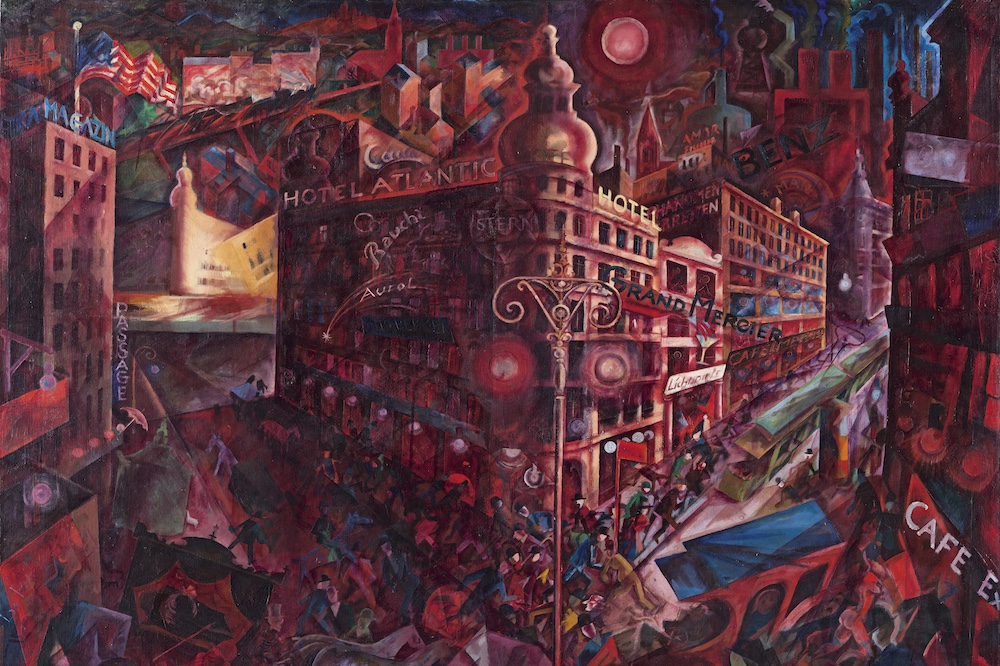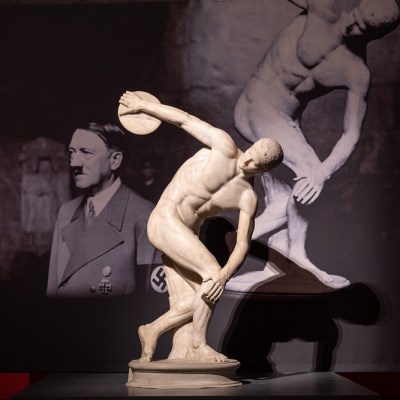From the April 2025 issue of Apollo. Preview and subscribe here.
Two boars – one cobalt, the other rose-pink – curl up in lush undergrowth beside a giant anemone bud. Franz Marc’s Wild Pigs (Boar and Sow) (1913) is a painting of contained animal vitality, perhaps even porcine romance. Displayed opposite is a blaring street scene by George Grosz – Metropolis (1916–17). Skeletons walk among the human throng beneath sickly neon lights and a sky lit by the ruby glow of brothel windows. On a third wall is Paul Klee’s Swamp Legend (1919), a fragmented landscape in slimy green and sombre violet which borrows its scratchy line and flat perspective from folk art.
It’s a peculiar selection, one dictated by these paintings’ unfortunate history rather than more subtle curatorial considerations. Under the direction of Joseph Goebbels, a Nazi commission judged these paintings – and thousands of their fellows – evidence of cultural deterioration and the decline of European civilisation. Such is the criterion for inclusion in ‘“Degenerate” art: Modern art on trial under the Nazis’ (at the Musée Picasso, Paris, until 25 May).
Metropolis (1916–17), George Grosz. Museu Nacional Thyssen-Bornemisza, Madrid. Photo: © Estate of George Grosz, Princeton, N.J./Adagp, Paris, 2024
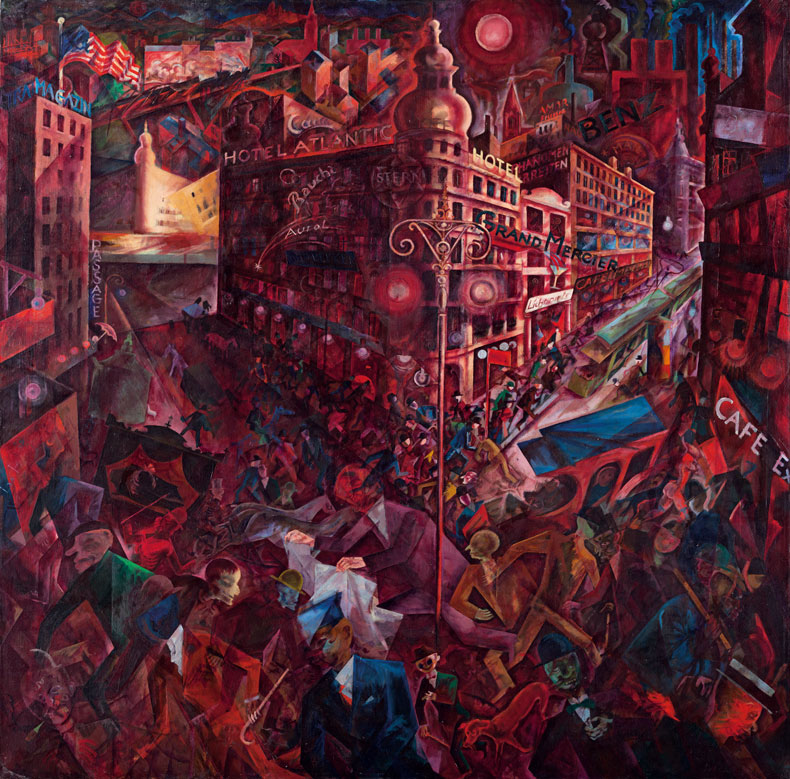
The exhibition’s location is significant. A terse round-up in a French newspaper in 1937 reports Göring’s ‘purification’ of public and private collections, with ‘the first victims: Chagall, Kokoschka, Picasso, Matisse, [and] Vlaminck’. Picasso’s interest in extra-European cultures – and the direct influence of African sculpture on works such as Les Demoiselles d’Avignon (1907) – was considered regressive. In architect Paul Schultze-Naumburg’s pseudo-scientific book Art and Race (1928), Picasso’s Seated Nude drying her feet (1921) was reproduced opposite medical images of children and adults with visible birth defects. Newspaper cuttings and correspondence included here show Picasso tracking his works and reputation as both slid beyond his control.
The process of removing tens of thousands of artworks from German museums commenced in June 1937. The following month, over 700 were displayed for public scorn in Munich. The exhibition, titled Entartete ‘Kunst’ (‘Degenerate “Art”’) toured Germany and Austria for four years. Documentation shows Klee’s Swamp Legend in a display mocking Dada, alongside works by Kurt Schwitters. Ridiculing Dada is, on reflection, quite the self-own, but just because an act is dumb does not mean it is not dangerous. The Schwitters works in the photograph did not survive.
That exhibition coincided with the first edition of the party-approved ‘Great German Art Exhibition’ – a display of muscular sculpture and realist painting through which Hitler pursued his ‘relentless war of purification’ within the cultural sphere. In Munich, the degenerate art show attracted two million visitors – the ‘Great German Art Exhibition’ around a quarter of that. Some derive from these figures the comforting assumption that more were visiting to admire than mock. Who’s to say? Hate-viewing and public pile-ons are not just phenomena of the social-media age. There have always been plenty eager to ridicule recent tendencies in art.
Seated Nude drying her feet (1921), Pablo Picasso. Photo: Jens Ziehe; © bpk/Nationalgalerie, SMB, Museum Berggruen/Succession Picasso 2024
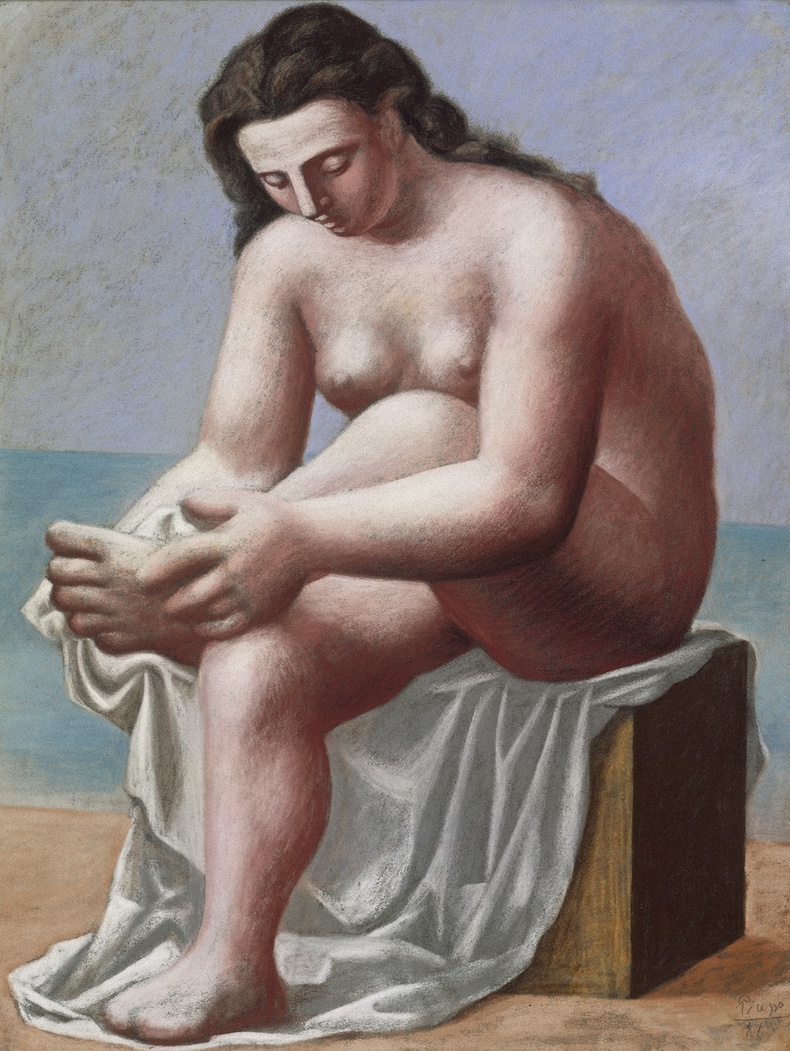
Works not placed on public display were warehoused. Photographs show racks of paintings by Marc, Picasso, Van Gogh and others stored in a great jumble. Some were destroyed. Others were sold to raise funds: in the summer of 1939, 125 works confiscated from German museums were auctioned at Galerie Fischer in Lucerne. Four dealers in modern art – Karl Buchholz, Ferdinand Möller, Bernhard Alois Böhmer and Hildebrand Gurlitt – were tasked with selling off much of the rest. (A handful of paintings here derive from the ‘Gurlitt hoard’ – works retained by Gurlitt’s son, discovered in Munich in 2012.)
What marked a work – or its author – as degenerate? Klee was condemned for his interest in work by children and those in psychiatric institutions. Marc Chagall and Otto Freundlich were of Jewish heritage. The latter was a friend of Picasso: displayed beside his humanist painting Homage to the People of Colour (1935) at the Musée Picasso are letters to Picasso in a firm and looping script. They end in 1943, when Freundlich was transported to an extermination camp. If your art did not conform to the pure ideal, though, nothing could save it – not race, not political allegiance, not even fans within the regime. Marc had died fighting in the German army during the First World War. Emil Nolde joined the Nazi Party (and not just for pragmatic reasons). Eventually the work of both was condemned.
Marc Chagall’s painting The Pinch of Snuff (Rabbi) (1923–26) being auctioned at Galerie Fischer, Lucerne, in June 1939. © Gotthard Schuh/Fotostiftung Schweiz
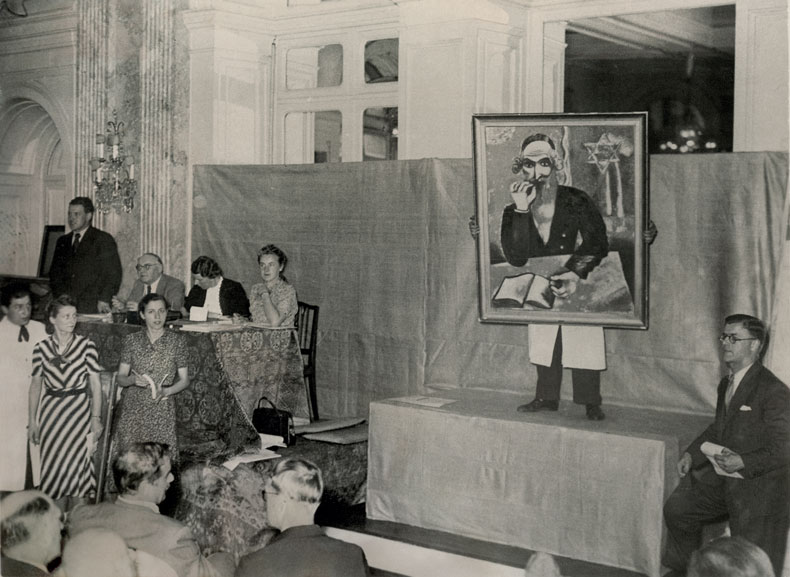
Is it possible to ‘see’ the art in an exhibition such as this, occluded by the boot polish, ashes and vault dust of history? Works that stay in mind invariably do not do so for positive reasons. It’s hard to erase the spectacle of Chagall’s The Pinch of Snuff (Rabbi) (1923–26) being held aloft for bidding at Galerie Fischer – a painting of a rabbi auctioned to raise funds for a fascist regime building infrastructure to facilitate the mass-execution of Jews.
We currently sit in the trans-fat-stained shadow of an American president meddling in his county’s cultural institutions and calling for a ‘golden age’ of art, free of ‘anti-American propaganda’. Glib parallels would be in poor taste: some artists whose work was condemned by the Nazis later faced execution. Nevertheless, there are lessons here. Ninety years on, these artists remain familiar not because they were condemned as degenerate but because of their work. Many who lived through the Second World War continued to make art in difficult circumstances, knowing that they could neither show nor sell it. Many were forced to emigrate. These artists resisted pressure to internalise the structures of control imposed by a bullying regime, and refused to submit to self-censorship, even if that meant public shame, ridicule and a loss of livelihood.
From the April 2025 issue of Apollo. Preview and subscribe here.
